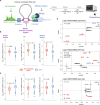3D chromatin architecture, BRD4, and Mediator have distinct roles in regulating genome-wide transcriptional bursting and gene network
- PMID: 39121214
- PMCID: PMC11313860
- DOI: 10.1126/sciadv.adl4893
3D chromatin architecture, BRD4, and Mediator have distinct roles in regulating genome-wide transcriptional bursting and gene network
Abstract
Discontinuous transcription is evolutionarily conserved and a fundamental feature of gene regulation; yet, the exact mechanisms underlying transcriptional bursting are unresolved. Analyses of bursting transcriptome-wide have focused on the role of cis-regulatory elements, but other factors that regulate this process remain elusive. We applied mathematical modeling to single-cell RNA sequencing data to infer bursting dynamics transcriptome-wide under multiple conditions to identify possible molecular mechanisms. We found that Mediator complex subunit 26 (MED26) primarily regulates frequency, MYC regulates burst size, while cohesin and Bromodomain-containing protein 4 (BRD4) can modulate both. Despite comparable effects on RNA levels among these perturbations, acute depletion of MED26 had the most profound impact on the entire gene regulatory network, acting downstream of chromatin spatial architecture and without affecting TATA box-binding protein (TBP) recruitment. These results indicate that later steps in the initiation of transcriptional bursts are primary nodes for integrating gene networks in single cells.
Figures





References
-
- Tunnacliffe E., Chubb J. R., What is a transcriptional burst? Trends Genet. 36, 288–297 (2020). - PubMed
-
- Rodriguez J., Larson D. R., Transcription in living cells: Molecular mechanisms of bursting. Annu. Rev. Biochem. 89, 189–212 (2020). - PubMed
-
- Klindziuk A., Kolomeisky A. B., Understanding the molecular mechanisms of transcriptional bursting. Phys. Chem. Chem. Phys. 23, 21399–21406 (2021). - PubMed
Publication types
MeSH terms
Substances
LinkOut - more resources
Full Text Sources
Molecular Biology Databases

